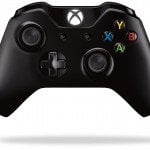The following review is an excerpt from the full Vamers Review of Microsoft’s Xbox One.
In my opinion, the Xbox 360 controller was the most ergonomic and comfortably designed controller of the former generation of consoles. Thankfully, the Xbox One Wireless Controller builds on this winning design through a few welcome modifications.
The Xbox One controller is slimmer and slightly smaller than its predecessor, more refined if you will. The battery pack, for example, has been integrated into the controller and no longer protrudes from the back. This small change means that the Xbox One controller is even more comfortable to hold than the Xbox 360 version.
Other changes appear to be mostly cosmetic, such as making the guide button glow white whilst placing it a little higher than before (making the new controller reminiscent of the original Xbox controller), introducing a new ‘on-black’ colour scheme for the ABXY buttons using a new injected plastic method (gives the buttons a beautiful distended 3D effect) and replacing the start and back buttons with ‘View’ and ‘Menu’, respectively. The biggest change, however, comes in the form of the new triggers.
The reshaped triggers and shoulder buttons are a pleasure to use. Microsoft has kept the concave shape of the triggers, but has tapered the sides of each trigger to flow more naturally into the base of the controller. This slight ergonomic change allows the arch of your index fingers to comfortably grab and flow over the triggers. The shoulder buttons have also been revised to offer a more organic and cohesive feel. In addition to a new look and feel, the triggers now have rumble feedback and have been dubbed by Microsoft as ‘impulse triggers’.
The idea of adding rumble feedback to the triggers of a controller sounds inconsequential. However, it is great and a proper innovation to conventional controller design. The best way to explain the sensation of the Xbox One Wireless Controller’s unique impulse triggers is that it is similar to a 5.1 surround sound system, but exclusive to a person’s sense of tactile touch. The rumble feeling is accentuated because each of the four rumble motors in the controller can be operated independently.
Forza Motorsport 5 currently offers the best technical demonstration of the Xbox One Wireless Controller’s impulse triggers. Gear shifts, for example, can be felt during races with the rumble in the triggers accentuating as the engine reaches its highest revolutions per minute. New sensations are given to breaking as well, whereby the impulse triggers are sensitive enough to depict the nuances experienced when applying brakes at full force. The lock and release of ABS, for example, is felt perfectly. The addition of impulse triggers may be subtle, but once felt the immersive sensations are continuously craved.
The D-pad has also undergone a fair amount of change. The often criticised ‘circular’ pad has been replaced with a four button configuration. The buttons handle very well and are firm, responsive and have a low profile (not much movement from when pressed to being fully depressed). The Xbox One Wireless Controller also utilises both invisible reflective technology and LEDs to communicate with the console and Kinect, which will make pairing controllers to players and consoles much easier.
![Microsoft Xbox One Wireless Controller [Review] 1 Vamers - Review - Microsoft's Xbox One Review - Xbox One Controller](https://vamers.com/wp-content/uploads/2014/09/Vamers-Review-Microsofts-Xbox-One-Review-Xbox-One-Controller-1024x518.jpg)
As was the case with the Xbox 360’s controller, the battery life of the new Xbox One controller is simply exceptional. Having owned an Xbox One for 10 months, I have been able to put the controllers through their paces. One controller charge can last for well over 10 days of daily usage (one to three hour play sessions).
Overall the Xbox One’s controller is a fantastic evolution of what was already a great product, but it does have a downside. Unlike the PlayStation 4’s DualShock 4, the Xbox One controller does not have a headset jack. Instead, it features a proprietary connector that requires an additional add-on in order for gamers to be able to use their headsets for online gaming chat.
On a side note, the Xbox One can also be controlled by mobile devices using the Xbox SmartGlass application, which is available for Apple, Android and Windows Phone users. SmartGlass allows gamers to use their mobile devices to control the Xbox One system in a variety of ways, from text input through to launching games, snapping apps, and if the game supports it, additional controls.
Click here for the full Vamers Review of Microsoft’s Xbox One.
Owner, founder and editor-in-chief at Vamers, Hans has a vested interest in geek culture and the interactive entertainment industry. With a Masters degree in Communications and Ludology, he is well read and versed in matters relating to video games and communication media, among many other topics of interest.



![Microsoft Xbox One Wireless Controller [Review] 2 We take a look at and review the recently released Xbox One Wireless Controller for Microsoft's brand new Xbox One gaming console.](https://vamers.com/wp-content/uploads/2022/01/Vamers-Authors-Profile-Image-Hans-Haupt-2022-02-150x150.png)










![Razer Kraken V3 Pro Review – Welcome to Boomtown [Redux]](https://vamers.com/wp-content/uploads/2022/07/Vamers-Technology-Razer-Kraken-V3-Pro-Review-Banner-218x150.jpg)








